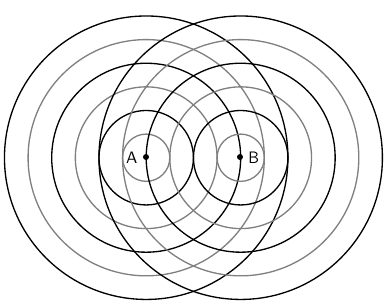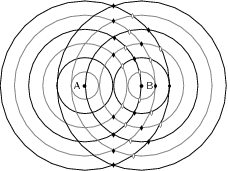| << Chapter < Page | Chapter >> Page > |
Constructive interference is the result of two waves with similar phase overlapping. This means that positive parts of one wave tend to overlap with positive parts of the other, and alike for the negative parts. When positive is added to positive and negative is added to negative, the net absolute displacement of the medium is greater than the displacements of the individual waves.
Destructive interference, on the other hand, is the result of two waves with non-similar phase (i.e. anti-phase) overlapping. This means that the positive parts of one wave tend to align with the negative parts of the second wave. When the waves are added together, the positive and negative contributions lead to a net absolute displacement of the medium which is less than the absolute displacements of either of the individual waves. A place where destructive interference takes place is called a node.
Waves can interfere at places where there is never a trough and trough or peak and peak or trough and peak at the same time. At these places the waves will add together and the resultant displacement will be the sum of the two waves but they won't be points of maximum interference.
Consider the two identical waves shown in the picture below. The wavefronts of the peaks are shown as black lines while the wavefronts of the troughs are shown as grey lines. You can see that the black lines cross other black lines in many places. This means two peaks are in the same place at the same time so we will have constructive interference where the two peaks add together to form a bigger peak.

Two points sources (A and B) radiate identical waves. The wavefronts of the peaks (black lines) and troughs (grey lines) are shown. Constructive interference occurs where two black lines intersect or where two gray lines intersect. Destructive interference occurs where a black line intersects with a grey line.
When the grey lines cross other grey lines there are two troughs in the same place at the same time so we will have constructive interference where the two troughs add together to form a bigger trough.
In the case where a grey line crosses a black line we are seeing a trough and peak at the same time. These will cancel each other out and the medium will have no displacement at that point.
On half the picture below, we have marked the constructive interference with a solid black diamond and the destructive interference with a hollow diamond.

To see if you understand it, cover up the half we have marked with diamonds and try to work out which points are constructive and destructive on the other half of the picture. The two halves are mirror images of each other so you can check yourself.
One of the most interesting, and also very useful, properties of waves is diffraction .

Notification Switch
Would you like to follow the 'Maths test' conversation and receive update notifications?